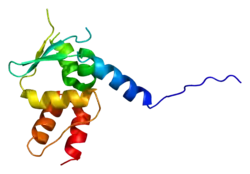Gigaxonin
Gigaxonin also known as kelch-like protein 16 is a protein that in humans is encoded by the GAN gene.[4][5][6]
| GAN | |||||||||||||||||||||||||||||||||||||||||||||||||||
|---|---|---|---|---|---|---|---|---|---|---|---|---|---|---|---|---|---|---|---|---|---|---|---|---|---|---|---|---|---|---|---|---|---|---|---|---|---|---|---|---|---|---|---|---|---|---|---|---|---|---|---|
 | |||||||||||||||||||||||||||||||||||||||||||||||||||
| |||||||||||||||||||||||||||||||||||||||||||||||||||
| Identifiers | |||||||||||||||||||||||||||||||||||||||||||||||||||
| Aliases | GAN, GAN1, KLHL16, gigaxonin, GIG, giant axonal neuropathy gene, GAN gene | ||||||||||||||||||||||||||||||||||||||||||||||||||
| External IDs | OMIM: 605379 MGI: 1890619 HomoloGene: 32523 GeneCards: GAN | ||||||||||||||||||||||||||||||||||||||||||||||||||
| |||||||||||||||||||||||||||||||||||||||||||||||||||
| |||||||||||||||||||||||||||||||||||||||||||||||||||
| |||||||||||||||||||||||||||||||||||||||||||||||||||
| |||||||||||||||||||||||||||||||||||||||||||||||||||
| Wikidata | |||||||||||||||||||||||||||||||||||||||||||||||||||
| |||||||||||||||||||||||||||||||||||||||||||||||||||
Function
Gigaxonin is a member of the cytoskeletal BTB / kelch (Broad-Complex, Tramtrack and Bric a brac) repeat family. (Kelch repeats are predicted to form a beta-propeller shape.) Gigaxonin plays a role in neurofilament architecture and is mutated in giant axonal neuropathy.[6]
References
- GRCh38: Ensembl release 89: ENSG00000261609 - Ensembl, May 2017
- "Human PubMed Reference:". National Center for Biotechnology Information, U.S. National Library of Medicine.
- "Mouse PubMed Reference:". National Center for Biotechnology Information, U.S. National Library of Medicine.
- Flanigan KM, Crawford TO, Griffin JW, Goebel HH, Kohlschutter A, Ranells J, Camfield PR, Ptacek LJ (Feb 1998). "Localization of the giant axonal neuropathy gene to chromosome 16q24". Ann Neurol. 43 (1): 143–8. doi:10.1002/ana.410430126. PMID 9450783. S2CID 33206272.
- Bomont P, Cavalier L, Blondeau F, Ben Hamida C, Belal S, Tazir M, Demir E, Topaloglu H, Korinthenberg R, Tuysuz B, Landrieu P, Hentati F, Koenig M (Dec 2000). "The gene encoding gigaxonin, a new member of the cytoskeletal BTB/kelch repeat family, is mutated in giant axonal neuropathy". Nat Genet. 26 (3): 370–4. doi:10.1038/81701. PMID 11062483. S2CID 2917153.
- "Entrez Gene: GAN giant axonal neuropathy (gigaxonin)".
Further reading
- Yang Y, Allen E, Ding J, Wang W (2007). "Giant axonal neuropathy". Cell. Mol. Life Sci. 64 (5): 601–9. doi:10.1007/s00018-007-6396-4. PMID 17256086. S2CID 8113473.
- Kuhlenbäumer G, Young P, Oberwittler C, et al. (2002). "Giant axonal neuropathy (GAN): case report and two novel mutations in the gigaxonin gene". Neurology. 58 (8): 1273–6. doi:10.1212/wnl.58.8.1273. PMID 11971098. S2CID 31121602.
- Ding J, Liu JJ, Kowal AS, et al. (2002). "Microtubule-associated protein 1B: a neuronal binding partner for gigaxonin". J. Cell Biol. 158 (3): 427–33. doi:10.1083/jcb.200202055. PMC 2173828. PMID 12147674.
- Strausberg RL, Feingold EA, Grouse LH, et al. (2003). "Generation and initial analysis of more than 15,000 full-length human and mouse cDNA sequences". Proc. Natl. Acad. Sci. U.S.A. 99 (26): 16899–903. Bibcode:2002PNAS...9916899M. doi:10.1073/pnas.242603899. PMC 139241. PMID 12477932.
- Bomont P, Ioos C, Yalcinkaya C, et al. (2003). "Identification of seven novel mutations in the GAN gene". Hum. Mutat. 21 (4): 446. doi:10.1002/humu.9122. PMID 12655563. S2CID 45580532.
- Ota T, Suzuki Y, Nishikawa T, et al. (2004). "Complete sequencing and characterization of 21,243 full-length human cDNAs". Nat. Genet. 36 (1): 40–5. doi:10.1038/ng1285. PMID 14702039.
- Gerhard DS, Wagner L, Feingold EA, et al. (2004). "The status, quality, and expansion of the NIH full-length cDNA project: the Mammalian Gene Collection (MGC)". Genome Res. 14 (10B): 2121–7. doi:10.1101/gr.2596504. PMC 528928. PMID 15489334.
- Benzinger A, Muster N, Koch HB, et al. (2005). "Targeted proteomic analysis of 14-3-3 sigma, a p53 effector commonly silenced in cancer". Mol. Cell. Proteomics. 4 (6): 785–95. doi:10.1074/mcp.M500021-MCP200. PMID 15778465.
- Allen E, Ding J, Wang W, et al. (2005). "Gigaxonin-controlled degradation of MAP1B light chain is critical to neuronal survival". Nature. 438 (7065): 224–8. Bibcode:2005Natur.438..224A. doi:10.1038/nature04256. PMID 16227972. S2CID 4401163.
- Wang W, Ding J, Allen E, et al. (2006). "Gigaxonin interacts with tubulin folding cofactor B and controls its degradation through the ubiquitin-proteasome pathway". Curr. Biol. 15 (22): 2050–5. doi:10.1016/j.cub.2005.10.052. PMID 16303566. S2CID 13939886.
- Olsen JV, Blagoev B, Gnad F, et al. (2006). "Global, in vivo, and site-specific phosphorylation dynamics in signaling networks". Cell. 127 (3): 635–48. doi:10.1016/j.cell.2006.09.026. PMID 17081983. S2CID 7827573.
- Leung CL, Pang Y, Shu C, et al. (2007). "Alterations in lipid metabolism gene expression and abnormal lipid accumulation in fibroblast explants from giant axonal neuropathy patients". BMC Genet. 8: 6. doi:10.1186/1471-2156-8-6. PMC 1810559. PMID 17331252.
- Houlden H, Groves M, Miedzybrodzka Z, et al. (2007). "New mutations, genotype phenotype studies and manifesting carriers in giant axonal neuropathy". J. Neurol. Neurosurg. Psychiatry. 78 (11): 1267–70. doi:10.1136/jnnp.2007.118968. PMC 2117591. PMID 17578852.
- Koop O, Schirmacher A, Nelis E, et al. (2007). "Genotype-phenotype analysis in patients with giant axonal neuropathy (GAN)". Neuromuscul. Disord. 17 (8): 624–30. doi:10.1016/j.nmd.2007.03.012. PMID 17587580. S2CID 23376570.
This article is issued from Wikipedia. The text is licensed under Creative Commons - Attribution - Sharealike. Additional terms may apply for the media files.



